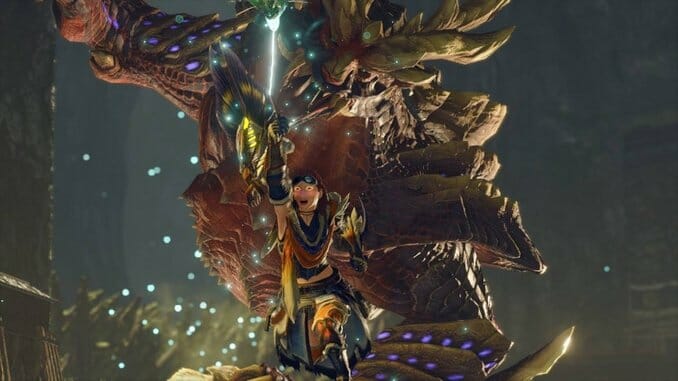Monster Hunter Rise: Polish in Precarity

Down the path from my camp, there is a grassland full of bovine creatures which swirl between the sun soaked hilltops and the dark valleys between. To get there I must descend into a narrow path within the forest, walk among the arcane holes that line the caves jutting out from the hill, cross the bridge which conveniently provides a shortcut across another decline, and then ascend up to emerge out from the trees into the hilltops.
Atop the hills I can only walk so close to any of the animals. The bovines mind their own business eating grass, huddling together for warmth. When I walk within 10 feet of them they begin to move away out of fear. Some turkey-like creatures walk down in a line and come to a confrontation with the four legged grass eaters. On a far off hilltop, a canine observes its possible prey, waiting for a safe moment to steal a meal.
This is not a place in Monster Hunter Rise, but a preserve that is about an hour walk from my house. None of these elements could really exist in Rise the same way that they do in this environment because Rise is a videogame that places the player’s volition above everything else. There are no risks of breaks and bruises hiking down the rough parts of a hill. The animals don’t signal or have a need for their own space which they deserve. There is no respect for the environment when moving through it. Through the animals, foliage, and rock there only exists an arena catered to the player’s whims.
As the series has run so long, many will already know whether they enjoy Monster Hunter or not. It isn’t about getting a clean kill without taking any damage; it’s a game focused on the trade-offs that take place in a fight. Your sword is heavy, and even at their fastest your character is sluggish. Opposing you is a large wyvern who can fly anywhere on the map, flip around, and maybe even shoot fire at you. You aren’t going to get out of any fight unscathed, and a single fight is a long haul that can take up to an hour at the higher difficulties. The brand new Monster Hunter Rise doesn’t make any major changes to this formula but it does change the landscape and speed these moments exist within.
Like the title’s name, one of the most major additions Rise brings to the series is the ability to access any part of the map through vertical movement. I don’t mean that there are ways of accessing traditional monster hunter areas through climbing vines. Rather, environmental elements that once blocked players into specific narrow paths have now all opened up and become climbable.
The player is given access to a new tool known as a “wirebug” which is essentially a limited use grappling hook that can be used to climb anywhere. And I mean anywhere.
If there is anything that still has me completely in awe every time I go to hunt, it’s that I rarely find any boundaries I can’t break in Rise. Mountains can be sprinted across and gaps leaped over. This isn’t necessarily impressive in the context of other open world games which tout these minor features. But as a Monster Hunter player for five games prior to this, I still have to adjust my thinking every time I play.

On top of the wirebug, a new buddy known as a “palamute” is introduced to the player, which can be mounted to double the player’s speed around a map, making travel effortless. Prior to this moment in the series, getting to a monster meant finding a meticulously specific path into certain areas by walking around each space with my slow character. Then, I may have had to search multiple areas for their entrails before actually getting to them. Now I go into a map, I see the monster on my HUD, and I bee-line straight to them.
Another addition to Rise is the ability for players to control monsters during their mount. Rather than stabbing away at a monster’s weakness, mounting now provides players the opportunity to participate in a battle between monsters. Many times when a monster is mounted, another nearby monster will come into the area for a battle. This gives the player the opportunity to experience monster attacks from a side of control rather than strategic defense. On top of this, it also provides players with extra material drops outside of the monster being hunted.
These major changes, along with some other minor alterations, create a hunting experience that feels smoother than any of the games prior to this point. Nothing ever feels like it can be blamed on the awkwardness of controls or obtuse information. Things just work a lot of times without having to think much further past the initial point. It feels nice, but in a lot of ways my favorite parts of the Monster Hunter series was providing space for awkwardness and obtuse information to exist in. Learning what was good to cook for my character, how to use specific weapons, and understand a map all took time. Now these things all have been somewhat simplified, or they just work from the get go.
-

-

-

-

-

-

-

-

-

-

-

-

-

-

-

-

-

-

-

-

-

-

-

-

-

-

-

-

-

-

-

-

-

-

-

-

-

-

-

-










































